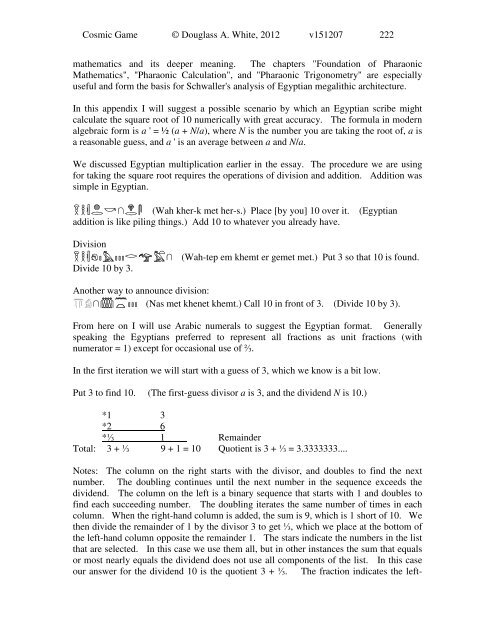Create successful ePaper yourself
Turn your PDF publications into a flip-book with our unique Google optimized e-Paper software.
<strong>Cosmic</strong> <strong>Game</strong> © Douglass A. White, 2012 v151207 222<br />
mathematics and its deeper meaning. <strong>The</strong> chapters "Foundation of Pharaonic<br />
Mathematics", "Pharaonic Calculation", and "Pharaonic Trigonometry" are especially<br />
useful and form the basis for Schwaller's analysis of Egyptian megalithic architecture.<br />
In this appendix I will suggest a possible scenario by which an Egyptian scribe might<br />
calculate the square root of 10 numerically with great accuracy. <strong>The</strong> formula in modern<br />
algebraic form is a ' = ½ (a + N/a), where N is the number you are taking the root of, a is<br />
a reasonable guess, and a ' is an average between a and N/a.<br />
We discussed Egyptian multiplication earlier in the essay. <strong>The</strong> procedure we are using<br />
for taking the square root requires the operations of division and addition. Addition was<br />
simple in Egyptian.<br />
nH¡<br />
H¡rQ!<br />
Q!rs (Wah kher-k met her-s.) Place [by you] 10 over it. (Egyptian<br />
addition is like piling things.) Add 10 to whatever you already have.<br />
Division<br />
nH¡y`m```r<br />
H¡y`m```rv6! (Wah-tep em khemt er gemet met.) Put 3 so that 10 is found.<br />
Divide 10 by 3.<br />
Another way to announce division:<br />
Z#!Vt```<br />
(Nas met khenet khemt.) Call 10 in front of 3. (Divide 10 by 3).<br />
!V<br />
```<br />
From here on I will use Arabic numerals to suggest the Egyptian format. Generally<br />
speaking the Egyptians preferred to represent all fractions as unit fractions (with<br />
numerator = 1) except for occasional use of ⅔.<br />
In the first iteration we will start with a guess of 3, which we know is a bit low.<br />
Put 3 to find 10. (<strong>The</strong> first-guess divisor a is 3, and the dividend N is 10.)<br />
*1 3<br />
*2 6<br />
*⅓ 1 Remainder<br />
Total: 3 + ⅓ 9 + 1 = 10 Quotient is 3 + ⅓ = 3.3333333....<br />
Notes: <strong>The</strong> column on the right starts with the divisor, and doubles to find the next<br />
number. <strong>The</strong> doubling continues until the next number in the sequence exceeds the<br />
dividend. <strong>The</strong> column on the left is a binary sequence that starts with 1 and doubles to<br />
find each succeeding number. <strong>The</strong> doubling iterates the same number of times in each<br />
column. When the right-hand column is added, the sum is 9, which is 1 short of 10. We<br />
then divide the remainder of 1 by the divisor 3 to get ⅓, which we place at the bottom of<br />
the left-hand column opposite the remainder 1. <strong>The</strong> stars indicate the numbers in the list<br />
that are selected. In this case we use them all, but in other instances the sum that equals<br />
or most nearly equals the dividend does not use all <strong>com</strong>ponents of the list. In this case<br />
our answer for the dividend 10 is the quotient 3 + ⅓. <strong>The</strong> fraction indicates the left-





